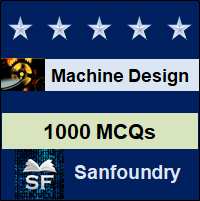This set of Machine Design Multiple Choice Questions & Answers (MCQs) focuses on “Heat Treatment and Case Hardening of Steels”.
1. Which of the following property is affected by heat treatment?
a) Hardness
b) Strength
c) Ductility
d) All of the mentioned
View Answer
Explanation: Heat treatment involves changes in the micro structure and hence all the internal properties are effected.
2. Annealing involves heating the component to a temperature
a) Slightly above the critical temperature
b) Equal to critical temperature
c) Slightly less than critical temperature
d) None of the mentioned
View Answer
Explanation: In annealing, component is heated to a temperature above than critical temperature.
3. Which of the following is true?
a) Rate of cooling in normalising is faster then in annealing
b) Annealing improves ductility
c) Normalising improves grain structure
d) All of the mentioned
View Answer
Explanation: In annealing, the furnace is switched off and component cools slowly. In normalising, component is air cooled.
4. Quenching
a) Consists of heating the component to critical temperature
b) Cooling rapidly
c) Increases hardness
d) All of the mentioned
View Answer
Explanation: During quenching, component is rapidly cooled which leads to formation of martensite. Hence hardness increases.
5. Tempering involves
a) Reheating the quenched component to a temperature greater than critical temperature
b) Increases the brittleness
c) Reheating the quenched component to a temperature equal to critical temperature
d) None of the mentioned
View Answer
Explanation: Tempering involves reheating the quenched product to a temperature less than transformation range. It improves ductility and reduces brittleness.
6. Silicon addition in spring steel increases its toughness.
a) True
b) False
View Answer
Explanation: Silicon addition increases strength without lowering the ductility.
7. Nickel addition in alloys
a) Increases toughness
b) Increases hardenability and impact resistance
c) Limit grain growth during heat treatment process
d) All of the mentioned
View Answer
Explanation: Nickel addition increases toughness by limiting grain growth.
8. Flame hardening involves
a) Heating the surface above the trAnswerformation range
b) Quenching after heating
c) Minimum case depth is 1mm
d) All of the mentioned
View Answer
Explanation: Flame Hardening is a process of heating the surface with a flame above critical temperature and then quenching it.
9. Induction hardening process involves
a) Heating surface by induction in field of invariable current
b) Case depth minimum of 2mm are produced
c) Heating surface by induction in field of alternating current
d) None of the mentioned
View Answer
Explanation: Heating can only be done in presence of alternating current and not constant current.
10. Case carburising involves
a) Introducing carbon at surface layer
b) Heating range 880 to 980’C
c) Case depths up to 2mm are possible
d) All of the mentioned
View Answer
Explanation: Case carburising involves introducing carbon at surface layer. Medium can be liquid, solid or gas and high case depths are possible.
11. Which of the following are not true for carbo nitriding?
a) Introducing carbon and nitrogen at surface layer
b) Component is heated in range of 650 to 920’C
c) Cyaniding is similar to carbo nitriding except that the medium is liquid
d) This process gives a lower wear resistance compared to case carburising process
View Answer
Explanation: Carbo nitriding gives wear resistance greater than compared to case carburising.
12. Which of the following are true for nitriding?
a) Nascent oxygen is involved
b) Temperature range 490 to 590’C
c) Gaseous or liquid medium
d) All of the mentioned
View Answer
Explanation: In nitriding nascent oxygen is acted on the surface of the product at a temperature of 490::590’C in a gaseous or liquid medium.
Sanfoundry Global Education & Learning Series – Machine Design.
To practice all areas of Machine Design, here is complete set of 1000+ Multiple Choice Questions and Answers.
If you find a mistake in question / option / answer, kindly take a screenshot and email to [email protected]
- Apply for Metallurgical Engineering Internship
- Apply for Mechanical Engineering Internship
- Check Mechanical Engineering Books
- Check Machine Design Books
- Check Metallurgical Engineering Books

